- Home
- Publications et statistiques
- Publications
- Monthly Business Survey – Start of Novem...
The Banque de France publishes a range of monthly and quarterly economic surveys that provide a snapshot of the French economy in the form of business climate indicators and short-term forecasts.
According to the business leaders surveyed (approximately 8,500 companies and establishments questioned between 27 October and 6 November), activity rose slightly in October in industry, market services and construction finishing works.
In November, business leaders expect further moderate growth in services activity, but little change in industry and construction. Order books continued to shrink in industry in October and fell to a new low in construction structural works.
In industry, business leaders reported further falls in raw material prices, whereas finished goods prices were deemed to be relatively stable. In all three main sectors, the share of companies that increased their prices over the previous month remained low, at close to pre-Covid levels.
Recruitment difficulties declined more markedly in October, but still affected 44% of companies (down from 49% in September).
Our indicator shows that uncertainty is starting to rise again, especially in construction. Cash positions improved slightly but were still considered to be weak in industry and services.
Based on the survey results as well as other indicators, we expect GDP to rise by between 0.1% and 0.2% in the fourth quarter (after 0.1% growth in the third quarter, in line with our forecast). The increase is expected to be driven by market services and, to a lesser extent, by a slight rebound in manufacturing. At this stage of the quarter, there is a substantial margin of uncertainty surrounding this estimate.
1. In October, activity increased slightly in industry, market services and construction finishing works
In October, activity rose slightly in industry, in line with business leaders’ expectations the previous month.
However, this masked contrasting trends across sectors.
The automotive industry, pharmaceuticals, chemicals, and computer, electronic and optical products all posted sharp rebounds, whereas activity declined in wood, paper and printing, and to a lesser extent in rubber and plastic products and machinery and equipment.
After falling steadily over the past 12 months, the capacity utilisation rate stabilised at 76%. It rose in the chemicals industry (to 75% from 73% in September) and in pharmaceuticals (to 82% from 79%).
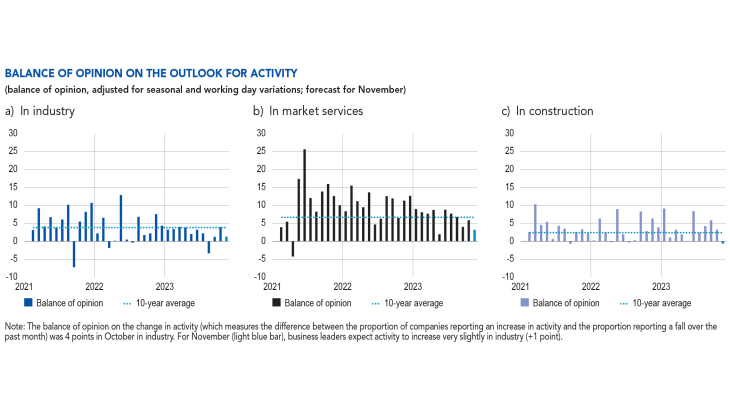
Inventories of finished goods were still deemed to be high in October. In the automotive and chemicals industries, they were well above their medium‑term level. Conversely, inventories declined in wood, paper and printing and in computer, electronic and optical products.
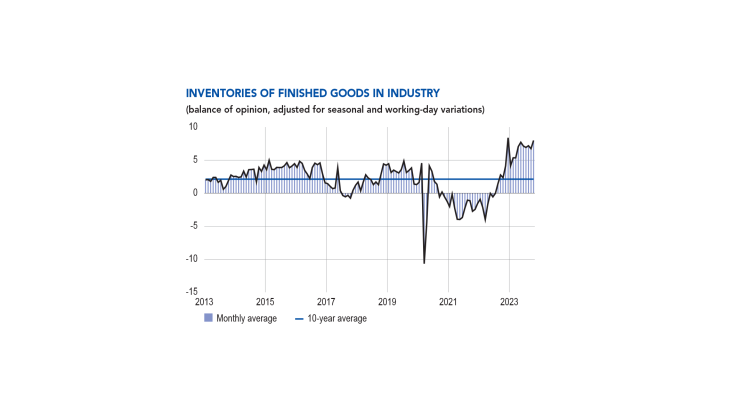
In market services, activity continued to improve. In the business services sector, activity was robust in management consultancy and in architectural, engineering, legal and accounting activities. After a very strong month in September, activity stabilised in personal services (accommodation and food services). In temporary employment, activity declined again in October.
In the construction sector, activity rose in finishing works but remained stable in structural works.
The balance of opinion on cash positions improved slightly but remained weak in industry; cash positions were considered to be good in aeronautics and pharmaceuticals, but were particularly low in wood, paper and printing, and in wearing apparel, textiles and footwear. In market services, cash positions improved in legal, accounting and food and beverage services.
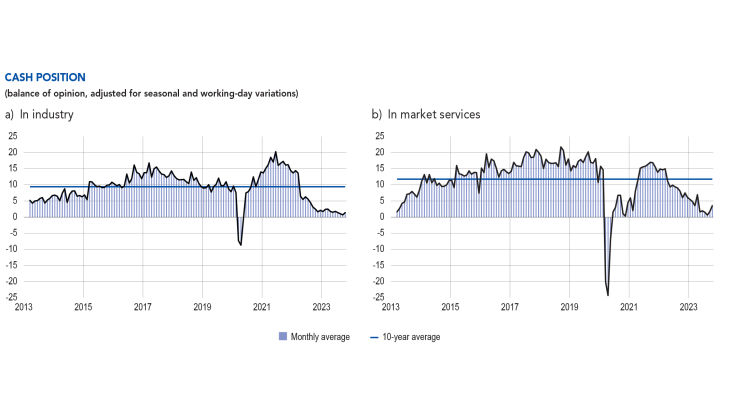
2. In November, business leaders expect activity to rise slightly in services but to remain little‑changed in industry and construction
Business leaders in industry expect activity to remain little‑changed in November. Whereas aeronautics and other industrial goods are expected to see a rise in output, the automotive and machinery and equipment industries should see a decline.
In services, activity is seen growing slightly, with further strong performances anticipated in business services (management consultancy, architectural and engineering
activities). Conversely, temporary employment activity is expected to fall again.
In construction, business leaders anticipate a modest rise in finishing works activity, but a marked fall in structural works.
The balance of opinion on industry order books deteriorated again in October. The aeronautics and computer, electronic and optical products industries were the only ones where order books were deemed to be good or very good. Order book levels were found to be particularly low in the wood‑paper‑printing, chemicals, rubber‑plastics and gri‑food industries.
In construction, order books in structural works shrank again, falling to a particular low in activities relating to the construction of single‑family homes. In finishing works, order books shrank slightly – to below their long‑term average – and business leaders said they had little visibility beyond the end of the year.
Our monthly uncertainty indicator, which is constructed from a textual analysis of comments by surveyed companies, shows that uncertainty is rising again, especially in construction, and that this is being attributed to a lack of visibility for 2024.
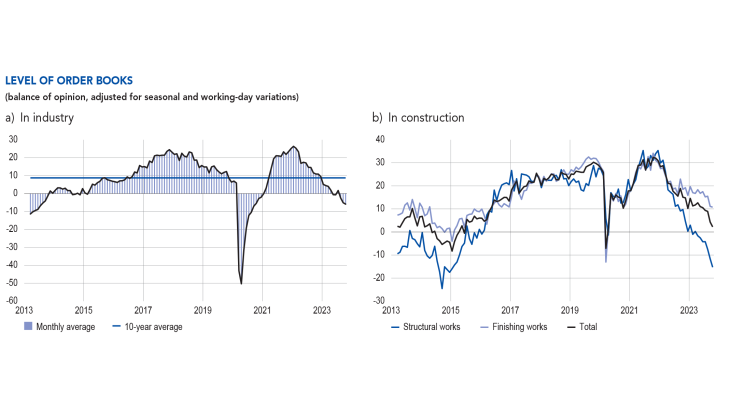
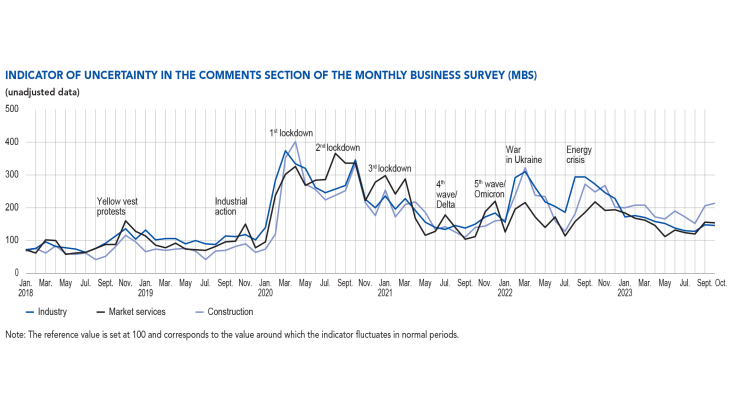
3. Confirmation of the moderation in prices
In October, supply difficulties stabilised at a relative low in industry (17% of businesses reported difficulties, in line with September) and continued to ease in construction (7% after 9% in September). In industry, business leaders said raw material prices continued to fall, whereas finished goods prices were reported to have remained almost stable.
At a more detailed level, 6% of industrial firms said they had raised their selling prices in October, compared with 23% in October 2022. Moreover, 6% of business leaders in industry reported lowering their selling prices in October (compared with 3% in October 2022), reflecting the easing of raw material prices. Decreases in finished goods prices were most common in wood, paper and printing (20% of firms lowered their prices), and in agri‑food and metal and metal products manufacturing (11%). In all of these sectors,
the share of firms that lowered their prices outstripped the share that raised their prices.
In construction, 13% of firms raised their prices in October (compared with 43% in October 2022), and the proportion was lower in structural works amid the downturn in activity (8% compared with 40% in October 2022).
In services, the share of firms reporting higher prices increased slightly to 11%, but was still well below the 20% share seen 12 months ago. Price rises were most common in management consultancy and cleaning services.
The share of business leaders planning to raise prices in November was similar to that seen in October in industry (5%), but lower in market services (7%) and construction (9%).
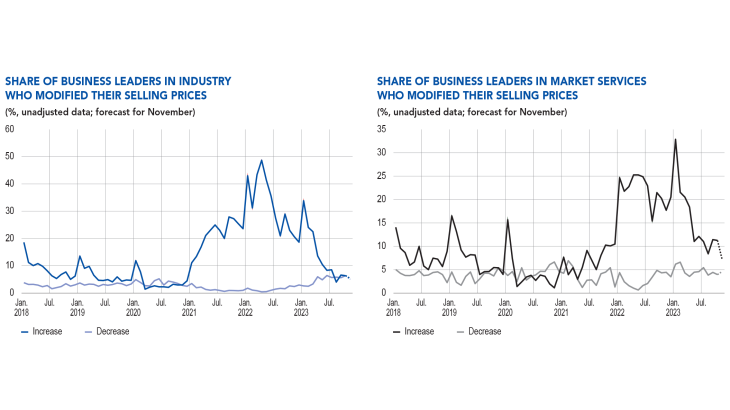
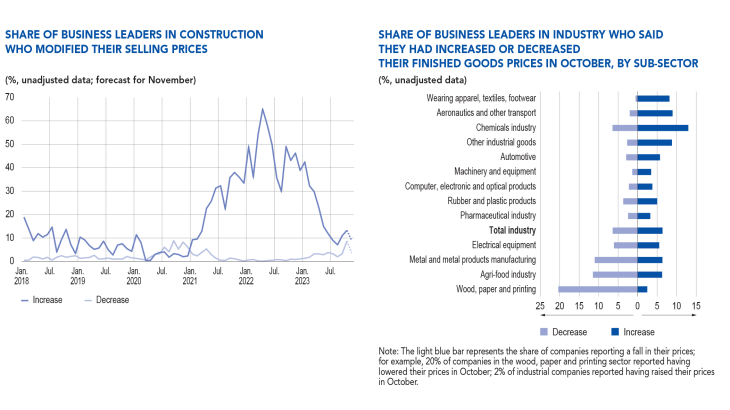
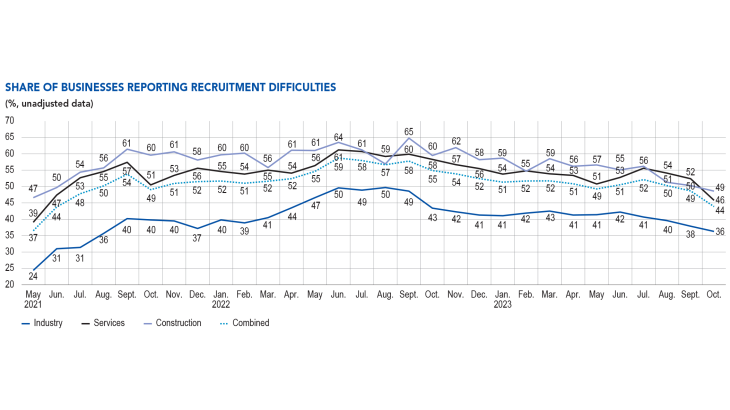
Business leaders were also asked about their recruitment difficulties. With private sector employment beginning to fall in the third quarter, the decline in recruitment difficulties accelerated in October, especially in services (notably business services, including temporary employment) and construction. They now concern 44% of the companies surveyed in all sectors, compared with 49% in September.
4. Our estimates point to further slight growth in activity in the fourth quarter
According to the quarterly national accounts published by INSEE at the end of October, GDP expanded by 0.1% in the third quarter, in line with the forecast in our previous monthly business survey published on 9 October 2023. The contractions in manufacturing and, to a lesser extent, in construction were more than offset by a slight rise in activity in the energy and services sectors.
Based on the results of the Banque de France Monthly Business Survey, as well as other available data (INSEE production indices and surveys, and high‑frequency data), we estimate that real GDP will rise by between 0.1% and 0.2% in the fourth quarter compared with the previous quarter. Economic activity
should therefore continue to expand slightly, driven by market services and by a small rebound in manufacturing. At this stage, however, there is a substantial margin of uncertainty surrounding this estimate.
The positive outlook for output and deliveries suggests that value added in manufacturing should start to rise this quarter. The energy sector should see a small decline after four quarters of growth stemming from the reopening of France’s nuclear power stations. Market services activity is expected to expand, driven notably by information and communication as well as business services. Construction should see a marked downturn this quarter, reflecting the sharp drop in housing starts.
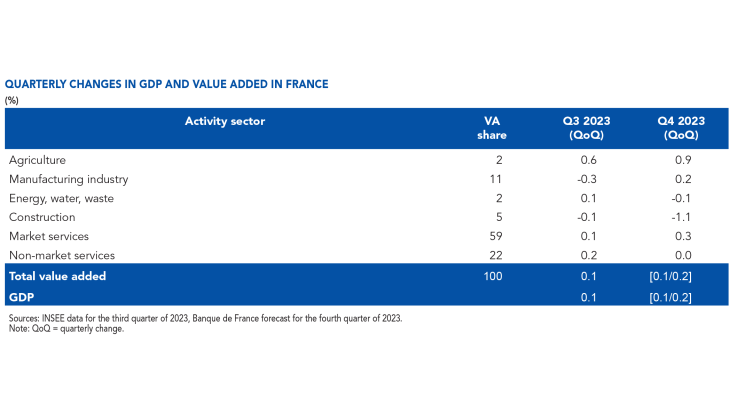
Download the paper
Updated on the 25th of July 2024